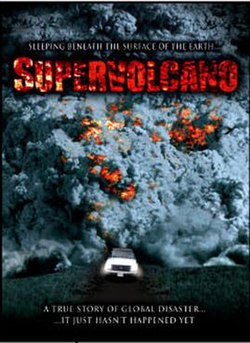Plot
Richard Lieberman, the scientist in charge at Yellowstone Volcano Observatory, gives a press conference with his colleagues Jock Galvin, Dave, Matt and Nancy, and their boss, Michael Eldridge, to present their new virtual imagery simulator VIRGIL, which Eldridge claims will greatly aid in their research. Reporter Maggie Chin asks about the possibility of an eruption, which Rick dismisses as a remote possibility.
After an earthquake triggers a tsunami on one of the park's lakes, Maggie interviews Kenneth "Ken" Wylie on TV about his new book on volcanoes. Rick and Ken are brothers-in-law. The two later argue, with Rick accusing Ken of creating a mass panic to sell his book.
The undersecretary of FEMA, Wendy Reiss, eventually asks Rick about the worst-case scenario if Yellowstone does release a "super eruption". He shows her a simulation, revealing the devastating results of an ashfall across the US if the volcano were to ever erupt.
After a hydrothermal event at the Norris Geyser Basin and more questions from the press, Rick's team runs a simulation of possible eruptions on VIRGIL. They learn that even a moderate eruption could potentially destabilize the rest of the magma chamber under Yellowstone and trigger a super eruption.
After more seismic events, the park is closed. Maggie comes to Yellowstone anyway, and Rick sends Matt to give her a tour of the park. They discover a harmonic tremor near Norris, indicating that an eruption of unknown scale is imminent.
An email about the expected eruption leaks to the press, causing a national panic. FEMA schedules a press conference in Washington, DC, at which Rick is pressured into saying that the eruption will not be large.
While Rick is flying back from the conference, his colleagues in the field office finish plugging in the latest data for the eruption. They discover that the top of the magma chamber alone has more than enough eruptible magma to destabilize the chamber and trigger a super eruption. As they realize this, the volcano erupts, severely damaging their field office and injuring Jock. Matt investigates the eruption and contacts Dave about it to inform Rick. A pyroclastic flow forces the team to abandon the main USGS office and flee; Jock flees in the helicopter while Nancy and Matt use their truck, but the flow outpaces and kills them both.
Rick contacts Dave, another team member who left before the eruption to set up a backup office in a hotel in Bozeman. Meanwhile, the vent is blowing ash east across the US and across major commercial air routes, prompting FEMA to clear American airspace and take other protective measures. Rick's plane flies into the ash cloud, damaging the engines, and they make an emergency landing in Cheyenne. Rick and Ken decide to go to the FEMA office in Denver but are caught under the ashfall and decide to look for a nearby military installation instead.
The motel roof collapses due to heavy ashfall after more caldera vents open, destroying the backup office and killing Dave. Rick and Ken reach the military installation safely. Weathering the eruption inside the installation, Rick contacts FEMA and determines that the vents will merge into one massive caldera in an eruption on the scale of the Huckleberry Ridge Eruption, the largest in Yellowstone's history.
Government officials try to design a plan to save the 25 million people trapped by the ashfall, but Rick convinces them that they cannot possibly hope to do so; the ash will make it impossible for planes to safely evacuate people or drop supplies. Instead, following his advice, FEMA creates the "Walk to Life" program, telling people to walk through the ash to safety.
One week after the eruption starts, the ground above the magma chamber begins to fall into the empty space left by the ejected magma, signalling the end of the eruption. However, the damage has been done; the lingering atmospheric effects causes a volcanic winter to occur. Much of the US is rendered uninhabitable, some are liquidated by the eruption without the possibility of restoration. The Walk to Life program saves 7.3 million of the 25 million people trapped by the ash, including Rick and Ken.
